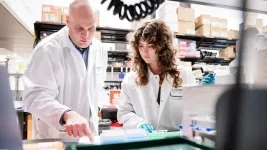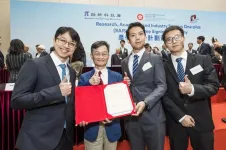(Press-News.org) Artificial Intelligence (AI) tools can play a key role in medical imaging if radiologists trust in their design, deploy them with adequate training and establish clear guidelines regarding clinical accountability, according to a recently published Special Report in Radiology: Artificial Intelligence, a journal of the Radiological Society of North America (RSNA).
RSNA and the Medical Image Computing and Computer Assisted Intervention (MICCAI) Society have led a series of joint panels and seminars focused on the present impact and future directions of AI in radiology. These conversations have collected viewpoints from multidisciplinary experts in radiology, medical imaging and machine learning on the current clinical penetration of AI technology in radiology, and how it is impacted by trust, reproducibility, explainability and accountability. The collective points gathered from the conversations define the cultural changes for radiologists and AI scientists working together and describe the challenges ahead for AI technologies to meet broad approval.
The Special Report presents these expert perspectives from MICCAI and RSNA on the clinical, cultural, computational, and regulatory considerations essential to adopt AI technology successfully in radiology. The article also emphasizes the importance of collaboration to improve clinical deployment. It highlights the need to integrate clinical and medical imaging data and introduces strategies to ensure smooth and incentivized integration.
“This report explores the views of leading experts to understand how best to deploy AI tools into clinical radiology practice,” said lead author Marius George Linguraru, D.Phil., Connor Family Professor and Endowed Chair of Research and Innovation at Children's National Hospital. “AI tools can play a key role in radiology, but radiologists must be able to trust in the systems’ design and receive adequate training. As the physicians most familiar with these tools, radiologists should establish clear guidelines regarding clinical accountability.”
The article addresses important clinical considerations, such as data sharing, annotation, bias and model performance of deploying AI in radiology practice. The authors suggest that tools to exchange data either for centralized analytics or distributed learning will be able to support sharing of data and/or models but will require additional institutional infrastructure and support. They also believe that image annotation may become a less significant hurdle in the next 5 to 10 years. Finally, they maintain that AI models built with small datasets or in-house data can navigate challenges related to data bias and diversity if they are applied to targeted populations and carefully monitored.
The report also explores cultural considerations, including volumetrics, outcome prediction, human-machine interaction, and trust and accountability.
The authors predict that training radiologists to work with AI tools will become routine. They argue that motivation for radiologists to use AI is key to increasing clinical efficiency and the ability to perform complex tasks. They also stress that AI tools be designed with the trust of radiologists and clear definitions of clinical accountability.
Computational considerations noted in the report include hardware ability, AI performance, communication between radiologists and AI scientists, and continuous evaluation.
The report asserts that cloud computing may be most effective for radiology departments that lack hardware and maintenance resources. It also suggests that the design, development, deployment and monitoring of radiology AI tools should be done by data scientists and radiologists working together, and that clinical institutions should prioritize the data flow from acquisition devices to PACS and/or data lakes and to AI servers.
The report also addresses regulatory guidelines and approval. The authors note that radiology is the leading application field of FDA-approved medical AI devices. They add that vision and language models can positively impact the field of radiology and should undergo regulatory oversight. The authors emphasize that the role of regulatory approval in AI’s implementation into clinical practice will require ongoing consideration.
The outlook for AI deployment in radiology is promising. Large and general foundation and generative AI models, including vision and language models, can impact the clinical adoption of AI tools and may help reduce burnout in radiology. Financial incentives to use AI will encourage hospitals to invest in AI-based software and increase the motivation for clinicians to use new technologies. To advance radiology AI tools in clinical care and research, multi-disciplinary societies can adopt a unified agenda, language and set of expectations.
“By collaborating across societies and disciplines, AI in medical imaging can achieve its full potential and provide value for clinical practice and research,” Dr. Linguraru said.
###
“Clinical, Cultural, Computational, and Regulatory Considerations to Deploy AI in Radiology: Perspectives of RSNA and MICCAI Experts.” Collaborating with Dr. Linguraru were Spyridon Bakas, Mariam Aboian, Peter D. Chang, Adam E. Flanders, Jayashree Kalpathy-Cramer, Felipe C. Kitamura, Matthew P. Lungren, John Mongan, Luciano M. Prevedello, Ronald M. Summers, Carol C. Wu, Maruf Adewole and Charles E. Kahn, Jr
Radiology: Artificial Intelligence is edited by Charles E. Kahn Jr., M.D., University of Pennsylvania (Penn) Perelman School of Medicine, Philadelphia, and owned and published by the Radiological Society of North America, Inc. (https://pubs.rsna.org/journal/ai)
RSNA is an association of radiologists, radiation oncologists, medical physicists and related scientists promoting excellence in patient care and health care delivery through education, research and technologic innovation. The Society is based in Oak Brook, Ill. (RSNA.org)
END
FOR IMMEDIATE RELEASE
With renewed funding of up to $98.8 million for seven years, Johns Hopkins Medicine scientists will continue to be a worldwide resource for discovering the genes and their variations that contribute to human disease.
Leaders of the Johns Hopkins Center for Inherited Disease Research, established in 1996, received the fourth consecutive renewal for up to $98,880,900 in funds from a consortium of 10 institutes at the National Institutes of Health. The seven-year award is divided between ...
SAN FRANCISCO—Mark Petersen, MD, has seen firsthand the devastating effects of brain bleeds in premature babies. It’s an exceedingly common condition that affects up to 20 percent of infants born before 28 weeks of gestation, bringing an increased risk for developmental delays and autism.
“As a neonatologist and neuroscientist, it’s frustrating that we don’t have any treatments to counteract the harmful effects of bleeding in the developing brain, even though we know it often leads to lasting problems,” says Petersen, director ...
Reston, VA—The Journal of Nuclear Medicine (JNM)—the flagship publication of the Society of Nuclear Medicine and Molecular Imaging—has maintained its status as one of the top medical imaging journals worldwide, according to new data just released in Clarivate's 2023 Journal Citation Reports. With an impact factor of 9.1, JNM saw increases in its five-year impact factor, journal citation indicator, and article influence score, among other categories.
“This is an exciting time for nuclear medicine, with ground-breaking advances in molecular imaging, theranostics, artificial intelligence, and other areas,” said Johannes Czernin, MD, ...
Paper Title: Hepatitis C Virus Reinfection Among Men Who Have Sex With Men With HIV in New York City
Journal: Clinical Infectious Diseases, July 2024
Authors: Daniel S. Fierer, MD, Professor of Medicine (Infectious Diseases) at the Icahn School of Medicine at Mount Sinai, and other coauthors.
Bottom Line: This study provides new perspectives on transmission of hepatitis C virus (HCV), a virus that infects the liver and can be transmitted during injection of drugs, among men who have sex with men (MSM).
How: The researchers performed a prospective cohort study in New York City of MSM with HIV who had cleared ...
Astronomers have untangled a messy collision between two massive clusters of galaxies in which the clusters' vast clouds of dark matter have decoupled from the so-called normal matter. The two clusters each contain thousands of galaxies and are located billions of light-years away from Earth. As they plowed through each other, the dark matter—an invisible substance that feels the force of gravity but emits no light—sped ahead of the normal matter. The new observations are the first to directly probe the decoupling of the dark and normal matter velocities.
Galaxy ...
Lyda Hill Philanthropies has donated $290,000 to Cary Institute of Ecosystem Studies for the Western Fire & Forest Resilience Collaborative. The two-year grant will help to engage a research team within the Collaborative that is focused on wildfire-related challenges and solutions in Colorado, where Lyda Hill has deep family ties.
Led by Winslow Hansen at Cary Institute and launched with seed funding from the Gordon and Betty Moore Foundation, the Western Fire & Forest Resilience Collaborative joins together multidisciplinary ...
Research Highlights:
In mice with heart failure with preserved ejection fraction (HFpEF), increasing ketone supply to the heart allowed their hearts to utilize more ketones and produce more energy.
Researchers hope this study may help to improve our understanding of the complex and different root causes of HFpEF from a metabolic perspective and potentially identify targets for development of medications to treat HFpEF.
Note: The study featured in this news release is a research abstract. Abstracts ...
Electron microscopes have long been indispensable tools in scientific research, offering unparalleled resolution and magnification capabilities. However, current electron microscopy technologies face significant limitations, including high cost, large size, strong radiation damage to samples through interaction with the electron beam, and the need for cryogenic temperatures. A research team from City University of Hong Kong (CityUHK) is working on a new quantum electron microscope (QEM) to eliminate interaction between the electron beam and sample. At this stage, the team is using partial key components of QEM ...
ITHACA, N.Y. – A new Cornell University study provides evidence that a spillover of avian influenza from birds to dairy cattle across several U.S. states has now led to mammal-to-mammal transmission – between cows and from cows to cats and a raccoon.
“This is one of the first times that we are seeing evidence of efficient and sustained mammalian-to-mammalian transmission of highly pathogenic avian influenza H5N1,” said Diego Diel, associate professor of virology and director of the Virology Laboratory at the Animal Health Diagnostic ...
HOUSTON ― The University of Texas MD Anderson Cancer Center’s Research Highlights showcases the latest breakthroughs in cancer care, research and prevention. These advances are made possible through seamless collaboration between MD Anderson’s world-leading clinicians and scientists, bringing discoveries from the lab to the clinic and back.
Recent developments at MD Anderson include low-dose radiation for B-cell lymphoma, a target for overcoming treatment resistance in pancreatic cancer, decreased public trust in U.S. health agencies providing cancer information, ...




